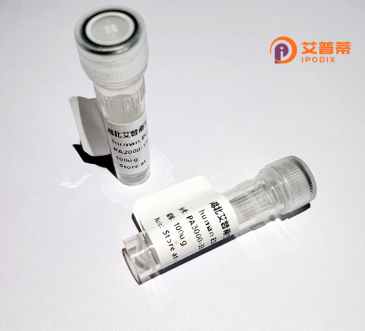
| 纯度 | >90%SDS-PAGE. |
| 种属 | Human |
| 靶点 | PRAF1 |
| Uniprot No | Q9UI14 |
| 内毒素 | < 0.01EU/μg |
| 表达宿主 | E.coli |
| 表达区间 | 1-419 aa |
| 活性数据 | MAAEVLPSARWQYCGAPDGSQRAVLVQFSNGKLQSPGNMRFTLYENKDSTNPRKRNQRILAAETDRLSYVGNNFGTGALKCNTLCRHFVGILNKTSGQMEVYDAELFNMQPLFSDVSVESELALESQTKTYREKMDSCIEAFGTTKQKRALNTRRMNRVGNESLNRAVAKAAETIIDTKGVTALVSDAIHNDLQDDSLYLPPCYDDAAKPEDVYKFEDLLSPAEYEALQSPSEAFRNVTSEEILKMIEENSHCTFVIEALKSLPSDVESRDRQARCIWFLDTLIKFRAHRVVKRKSALGPGVPHIINTKLLKHFTCLTYNNGRLRNLISDSMKAKITAYVIILALHIHDFQIDLTVLQRDLKLSEKRMMEIAKAMRLKISKRRVSVAAGSEEDHKLGTLSLPLPPAQTSDRLAKRRKIT |
| 分子量 | 73.7 kDa |
| 蛋白标签 | GST-tag at N-terminal |
| 缓冲液 | PBS, pH7.4, containing 0.01% SKL, 1mM DTT, 5% Trehalose and Proclin300. |
| 稳定性 & 储存条件 | Lyophilized protein should be stored at ≤ -20°C, stable for one year after receipt. Reconstituted protein solution can be stored at 2-8°C for 2-7 days. Aliquots of reconstituted samples are stable at ≤ -20°C for 3 months. |
| 复溶 | Always centrifuge tubes before opening.Do not mix by vortex or pipetting. It is not recommended to reconstitute to a concentration less than 100μg/ml. Dissolve the lyophilized protein in distilled water. Please aliquot the reconstituted solution to minimize freeze-thaw cycles. |
1. **"PRAF1 overexpression correlates with poor prognosis and induces apoptosis in human cancers"** - Zhang et al.
研究揭示了重组人PRAF1蛋白在肿瘤细胞凋亡中的作用,发现其过表达通过调控Bcl-2/Bax信号通路抑制癌细胞增殖,并与临床不良预后相关。
2. **"PRAF1 interacts with endocytic proteins and regulates vesicular trafficking"** - Wang et al.
通过重组PRAF1蛋白的体外结合实验,发现其与Rab GTP酶及网格蛋白适配体复合物的相互作用,提出PRAF1参与调控细胞内吞及囊泡运输功能。
3. **"Structural insights into the membrane association of PRAF1 through its C-terminal domain"** - Li et al.
利用重组PRAF1蛋白的晶体结构解析,揭示了其C端结构域介导的膜结合机制,为理解其在细胞器定位中的功能提供了分子基础。
4. **"PRAF1 modulates neurotransmitter release by interacting with synaptic proteins"** - Chen and Kumar
研究通过重组PRAF1蛋白的神经细胞表达,发现其与突触蛋白SNAP-25的互作,提示其在神经递质释放和突触可塑性中的调控作用。
PRAF1 (Prenylated Rab Acceptor 1), also known as FAM84A, is a member of the PRAF protein family characterized by its conserved prenylated Rab acceptor (PRA) domain. It is primarily localized to the Golgi apparatus and endoplasmic reticulum, playing a critical role in intracellular vesicular trafficking and membrane dynamics. PRAF1 interacts with Rab GTPases, which are essential regulators of vesicle formation, transport, and fusion, thereby influencing cargo sorting and organelle integrity. Studies suggest its involvement in neurotransmitter release, receptor recycling, and synaptic plasticity, linking it to neural function.
PRAF1 has garnered attention in cancer research due to its differential expression in malignancies. It is overexpressed in glioblastoma, prostate cancer, and neuroblastoma, where it may promote tumor progression by inhibiting apoptosis or enhancing cell migration. Conversely, reduced PRAF1 levels are associated with poor prognosis in certain cancers, indicating context-dependent roles. Structurally, human PRAF1 contains 218 amino acids, featuring four transmembrane domains that facilitate membrane anchoring. Recombinant human PRAF1 protein is typically produced via eukaryotic expression systems (e.g., HEK293 cells) to ensure proper post-translational modifications. Current research focuses on elucidating its molecular mechanisms in disease, identifying interaction partners, and exploring therapeutic targeting potential. Its dual roles in membrane trafficking and oncogenesis make PRAF1 a multifaceted protein of growing biomedical interest.
×